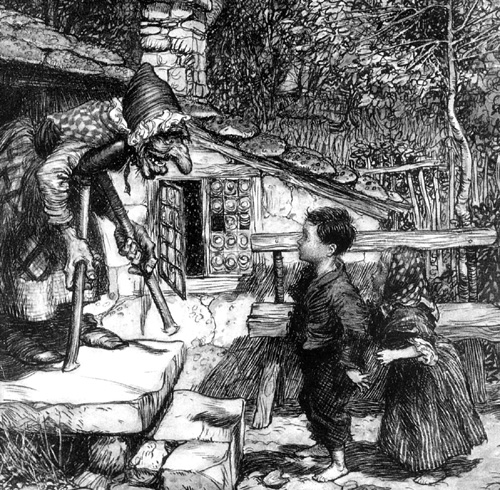 Hansel and Gretel
Hansel and Gretel
In honor of the film release of Maurice Sendak’s Where the Wild Things Are, I’ve been writing about children’s literature, when it’s truly moral and when it’s merely pious. It’s bad enough that the Victorians required their children to recite Issac Watt poems or that Christian fundamentalists rail against In the Night Kitchen or Are You There God, It’s Me Margaret. It’s even worse when the preaching is coming from a former Secretary of Education and National Endowment of the Humanities director. I’m thinking of William Bennett’s The Book of Virtues for Boys and Girls: A Treasury of Great Moral Stories (1996).
Here’s how Library Journal describes the book, as quoted on Amazon:
Believing with Plato that “tales which the young first hear should be models of virtuous thought,” former Secretary of Education Bennett has produced a McGuffey’s Reader for the Nineties. The author draws upon a variety of literature ranging from biblical stories to political legends and speeches to illustrate the catalog of virtues–self-discipline, compassion, work, responsibility, friendship, courage, perseverance, honesty, loyalty, faith–that he believes are foundational to strong moral character. Most selections are introduced by a short thematic note, e.g., “an honest heart will always find friends.”
Review Henry Carrigan observes, “Bennett’s elevation of these virtues to moral absolutes renders the book’s view of morality rather simplistic.”
I heard Bennett interviewed on the Diane Riem show about the book 13 years ago and remember him getting into an argument with a caller about “Hansel and Gretel.” I don’t recall all that he said, but his reading struck me as one-dimensional. He wasn’t wrong that the story raises issues about children needing to learn initiative and independence if they are to grow up and achieve a happy ending. It’s just that he moved so quickly to what children should learn from the story that he gave short shrift to children’s actual experiences.
“Hansel and Gretel” is primarily a story about eating. Eating is heavily symbolic for children (and, of course, for the rest of us), tied in with socialization and power issues. That’s why some of the great children’s classics are about eating, like Dr. Seuss’s Green Eggs and Ham and Eric Carle’s The Very Hungry Caterpillar. Among other things, eating in “Hansel and Gretel” is about the fantasy of unchecked desire. The mother claims that the children are eating the family out of house and home, and then, when Hansel and Gretel come across the house in the woods, they literally begin eating the house. Children listening to the story may project these eating desires upon the mother, who becomes a cannibalistic witch. There also may be issues of independence involved. I remember scaring and delighting my own children with the threat “I’m going to eat you” as I smothered them with affection. By turning the fear into a game, we defused it.
Like many fairy tales, “Hansel and Gretel” contains a grisly revenge fantasy against the parent: Gretel pushes the witch in the oven, burning her alive. Keep in mind that, in a child’s mind, stepmothers and witches in fairy tales are a stand-in for one’s actual mother. Because they are at a remove from “the good mother,” one can safely express one’s anger against them.
Bennett would probably agree with the overall arc of the story. As Bruno Bettelheim argues in Uses of Enchantment, “Hansel and Gretel” is ultimately about children learning to control their appetites and achieving self-control. But look at how moralists like Bennett see the story working: children are supposed to extract the moral without dwelling too much on the violent and rebellious images within. In fact, the less said on those the better.
However, children, as Maurice Sendak and others like him understand, are drawn to images of anger and unbridled desire. They feel understood when authors give them stories conveying these dramas. Adults who are threatened by the inner lives of children may try to short circuit the imagination and move directly to the “wholesome messasge.”
There are home schools where the children read only narrowly circumscribed fictions. Parents, fearing what their children might think, strive to control interpretation. Some of these parents assign Bennett’s Book of Virtues.
But imagination will out. One may try to control what the child gets out of “Hansel and Gretel,” but fantasies have a way of slipping the leash and running free despite adult efforts.
As I parent I was determined to inculcate good values in my kids. But rather than trying to censor their dark fantasies, I let the stories we read surface their concerns and then talked to them about what emerged. We discussed plot situations that intrigued them and characters they liked and didn’t like. I didn’t preempt their readings but followed their lead. I was rewarded with a rich insight into their inner lives. Regarding values, they were able to figure out what behavior to emulate and what to condemn.
Darien and Toby have grown up to become men with a strong sense of self who are inner directed, responsible, moral, and integrous. Julia and I allowed them their own space to imagine and they repaid our trust.

